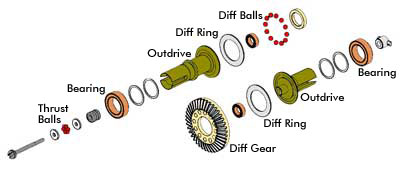
What is a Differential?
There are two different types of Differentials; a gear-style diff and a ball-style diff.
Gear diffs are comprised of a series of gears that transfer power from the input shaft to the wheels. Gear diffs are inexpensive to produce and can be quite durable, so you will find them in alot of RTR or Monster Truck vehicles. Gear diffs are also not externally adjustable. Adjusting a gear diff means removal from the vehicle and adding different viscosities of fluid to limit slip.
Balls diffs are more of an upgrade, or competition style diff. They use small balls and rings to limit slip. The more you tighten down the ball diff, the more pressure it takes to slip. Ball diffs do require a bit more maintenance, but can be externally adjusted to help the performance of your vehicle.
What is a OneWay Differential?
The One Way Differential simply removes diff action from the front of the car. You will no longer have a ball style differential in the front of your car. Instead, the ‘OneWay housing’ uses two (sometimes 4) ‘OneWay’ roller bearings that spin in one direction. Once your input shafts have been installed, the roller bearings will only allow them to spin in one direction…HOPEFULLY forward!!!
Tuning with a Differential
This one is pretty basic. Looser diff: low-traction tracks. Tighter diff: high-traction tracks. A tighter diff will allow more instant throttle response and greater acceleration.
All cars have their own adjustment rule. On most cars, there is a standard setting for the lightweight diffs and a standard setting for the steel diffs to make sure they work their best. As you tighten the diff bolt, make sure you tighten it down to where it is fully compressed, but DO NOT OVERTIGHTEN! This is extremely important. Once compressed, follow the manufacturers settings – no more, no less. Run the car for a complete pack, and re-check the diff setting.
In offroad, you want the diff as loose as possible without slipping. If you land off a jump and hear a ‘barking’ sound, your diff is too loose and you should tighten it up slightly.
Tuning with a OneWay Differential
Changing to the OneWay Diff is fairly simple. For the OneWay Diff, it requires you to remove the front Diff out of your car and slide the OneWay assembly in it’s place. All OneWays come pre-assembled…you will have to attach the gear and the outdrive cups.
For a OneWay Pulley, it’s a matter of removing the stock Pulley and just sliding this in it’s place. The OneWay Pulley also come pre-assembled.
The OneWay Diff allows the front wheels to free-spin (off power), giving you a much better cornering ability. This is because the front tires will not be fighting each other through the turn. You will, however, need to change your setup and driving style. Setup changes will include (possibly) a stiffer front spring, maybe heavier front oil, a softer rear spring or softer rear oil. As far as driving style, you will have to change that to a smoother, flowing style. No longer can you full throttle into a corner, slam the brakes, and power out of it! It does take some getting used to, but it is by far a much faster way around the track.
OneWay Diffs are recommended mostly on high bite tracks. The exception to this rule might be carpet, as the aggressiveness of the OneWay might be a bit too much.
Back to the RC Suspension Tuning Guide.
 CompetitionX CompetitionX is the most up-to-date source for RC Car News, Reviews and Videos for Radio Control. We also have the most comprehensive Manual Database on the web.
CompetitionX CompetitionX is the most up-to-date source for RC Car News, Reviews and Videos for Radio Control. We also have the most comprehensive Manual Database on the web.
3 comments
Pingback: One-way differential and Locked Differential « Project OTA R31
Pingback: Sources « Project OTA R31
Pingback: TT-01D hopup - R/C Tech Forums